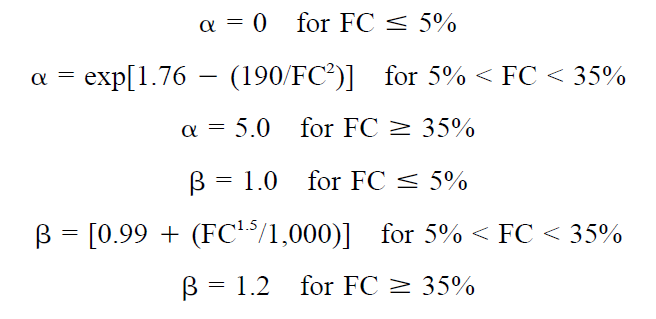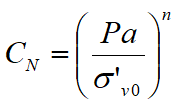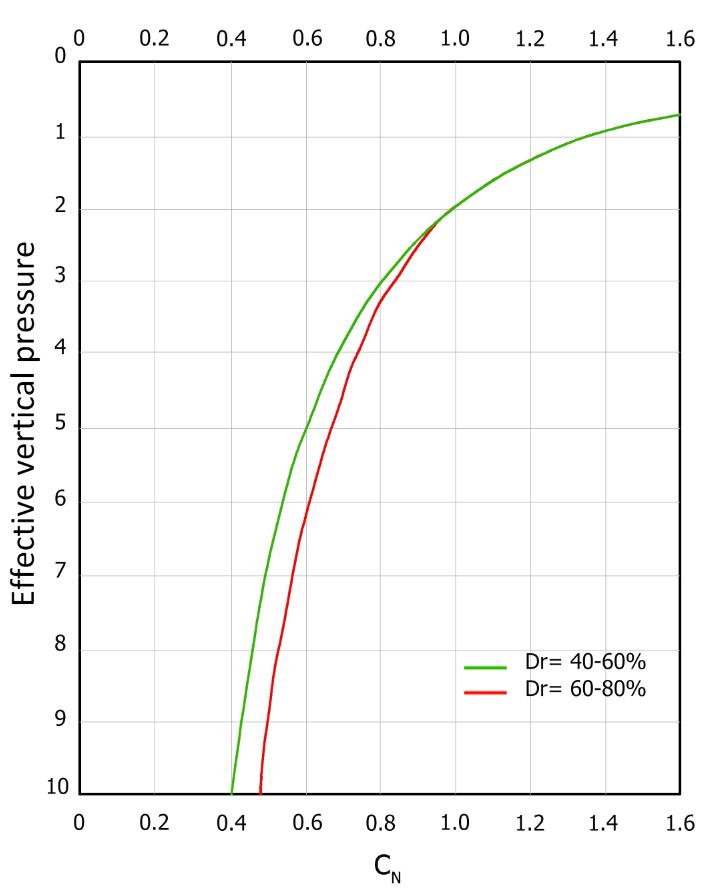The method of Seed e Idriss (1982) calculates the CSR using the following formula:

To determine the value of the reduction factor rd is used the formula proposed by (Liao e Whitman,1986):

For Magnitude 7,5 Earthquakes the original curve of Seed and Idriss (1982) is considered whose formula is:

This equation is valid for N1(60)<30. For N1(60)≥30, clean granular soils are too dense to liquefy and are classed as “non liquefiable”.
For different Magnitude (greater or less than 7.5) Seed e Idris (1982) intoduced the Magnitudo Scaling Factor MSF defined by following equation:

while for the correction factor MSF refers to the values reported in Table 1 obtained by several researchers, including Seed H. B. and Idriss I. M (1982).
Table 1- Scale factor of the magnitude derived from several researchers
Magnitude |
Seed H.B. & Idriss I.M. (1982) |
Ambraseys N.N (1988) |
NCEER (Seed R. B. et al) (1997; 2003) |
|---|---|---|---|
5,5 |
1,43 |
2,86 |
2,21 |
6,0 |
1,32 |
2,20 |
1,77 |
6,5 |
1,19 |
1,69 |
1,44 |
7,0 |
1,08 |
1,30 |
1,19 |
7,5 |
1,00 |
1,00 |
1,00 |
8,0 |
0,94 |
0,67 |
0,84 |
8,5 |
0,89 |
0,44 |
0,73 |
The Cyclic Resistance Ratio is calculated as a function of magnitude, the number of blows in the SPT test, the effective vertical pressure and the relative density.
Initially is calculated the corrected number of blows to the desired depth to take account of the lithostatic pressure by the following expression:
(N1)60CS= α+β(N1)60
where α e β are coefficients determined from the following relationships:

Other corrections that influence SPT results are incorporated in these corrections:
(N1)60 =NmCNCECBCRCS
where Nm is the measured standard penetration resistance; CN is a correction factor to normalize Nm to a common reference effective overburden stress; CE is the corretion for hammer energy ratio (ER); CB is the correction factor for borehole diameter; CR is the correction factor for rod length; and CS is the correction for samples with or without liners.
CN is determined by the relation:

where σ'vo is the effective pressure, Pa the atmospheric pressure (~ 100 kPa) expressed in the same units as σ'vo and n an exponent whose value is 0.5 and depends on the relative density of the ground (Figure 1).

Figure 1 – Correction coefficient CN
To illustrate the influence of magnitude scaling factors on calculated hazard, the equation for factor of safety (FS) against liquefaction is written in terms of CRR, CSR, and MSF as:
FS= (CRR7.5/CSR)MSF
where CSR is the calculated cyclic stress ratio generated by the earthquake shaking; and CRR7.5 is the cyclic resistance ratio for magnitude 7.5 earthquakes.
© Geostru